What Is False Ceiling | Why We Need False Ceiling | Types in False Ceilings | Advantages & Disadvantage of False Ceiling | False Ceiling Installation Steps by Step
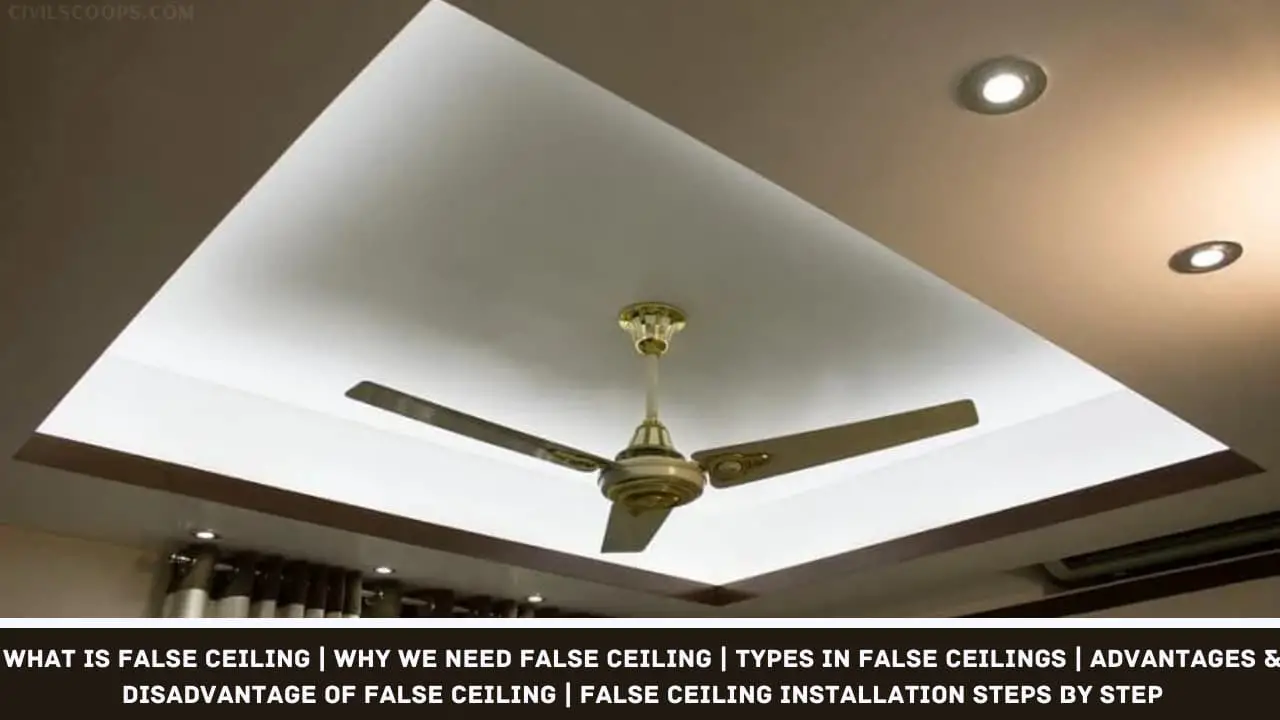
Table of Contents
Introduction of False Ceiling
The ceiling is the first thing which a person noticed whenever we entered the room. The Trend of Flat slabs in our home is fallen and nowadays there is a great demand for False Ceiling for the interior of the home.
A false ceiling is basically an Artificial roof which is made up of different types of materials and widely used in the rooms to increase its appearance. A false ceiling becomes an integral part of home construction.
It is a dream of every person to construct their own house which has a high quality interior design. Nowadays, the craze towards the Interiors and the false ceiling is increased.
A good false ceiling will create a great impression and helps to increase the aesthetical beauty of the home and make it worth living.
False ceiling is one of the most important parts of your house which helps to improve the aesthetical value of the structure. There are various types of false ceilings are available in the market but it is very difficult to choose the best and budget-friendly false ceiling.
Due to lack of knowledge, people do not know how to choose the best false ceiling at an affordable price. If you are planning to install the false ceiling in your home then you are at the right place.
In this article, you will get to know all about the false ceiling and the types in the false ceiling with its suitability and price. After reading this article, you will be able to take a proper decision to choose the best false ceiling for your house.
What Is False Ceiling?
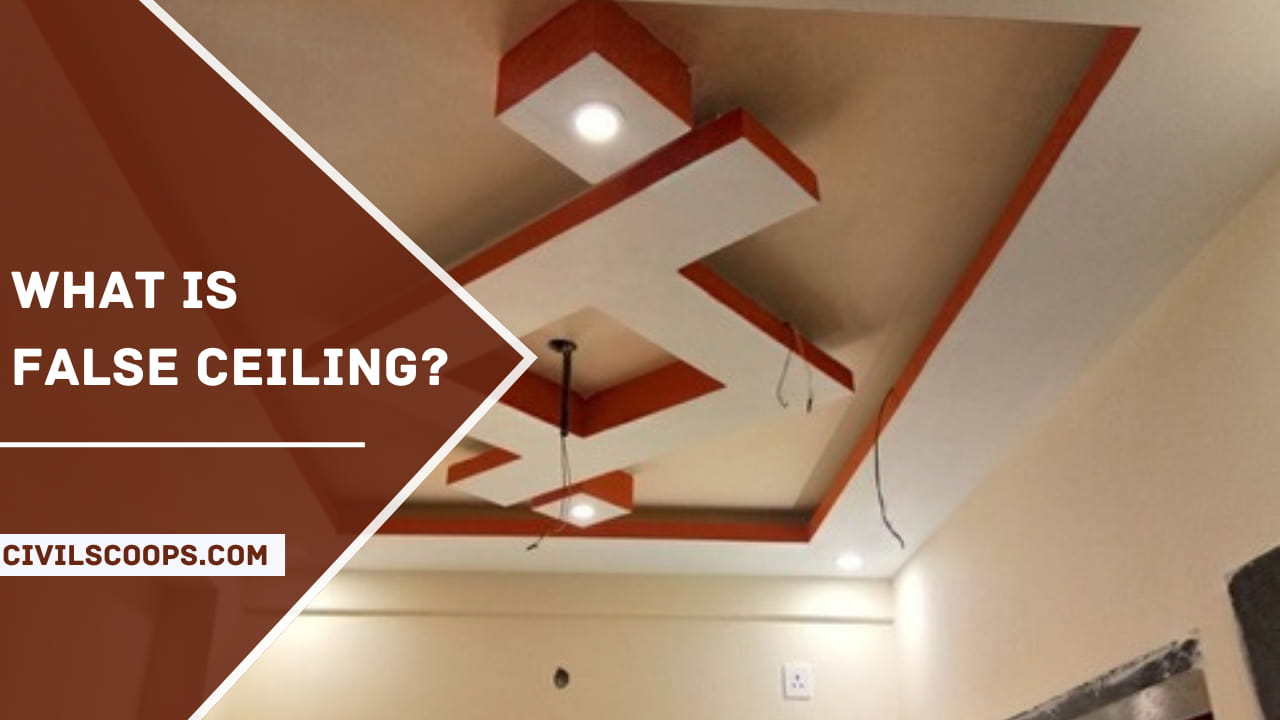
There are two types of ceilings, primary and secondary ceilings. The primary ceiling is a roof structure and the secondary ceiling is a false ceiling. The false ceiling is a special type of ceiling which is fitted just below to the slab or original ceiling of the structure. False ceilings
are asking known as the suspended ceiling.
False ceiling is a second layer of the roof which is installed just below to the slab with the help of a metal or the wooden frame. The false ceiling is hung or fixed in the structured framework which is made up of aluminium or galvanized iron or a wooden
section.
The false ceiling is made up of different types of materials such as plaster of Paris, plywood, Gypsum board and PVC sheets etc. There are various types of false ceilings are available in the market with different designs.
Why We Need False Ceiling?
Today Interior decor of the home is a need. It will help to improve the aesthetical beauty of the home. False ceiling plays a vital role in increasing the Aesthetical value of the room.
A false ceiling provides a neat, clean and uniform look which is very pleasing. False ceilings are widely used in the corporate offices because it gives aesthetical beauty and provides a rich quality environment which will increase your work efficiency.
If the False ceilings are not provided, then the lights are fixed on the walls due to which their many electric wiring works are done on the walls which do not give a good look to the room.
There are many electric wirings are clattered in the room which is not good as per as the safety is concerned. The false ceiling will hide all these electric wirings and gives an attractive look to the room.
There are also some unwanted Structural elements such as beams whose some part is under the roof which does not give a good look. False ceiling helps to hide all these unwanted elements of the room and provide a uniform and clean look to the room.
The false ceiling is widely used in the room where sound resistance is necessary such as meeting rooms, conference rooms and seminar halls etc.
Types in False Ceilings
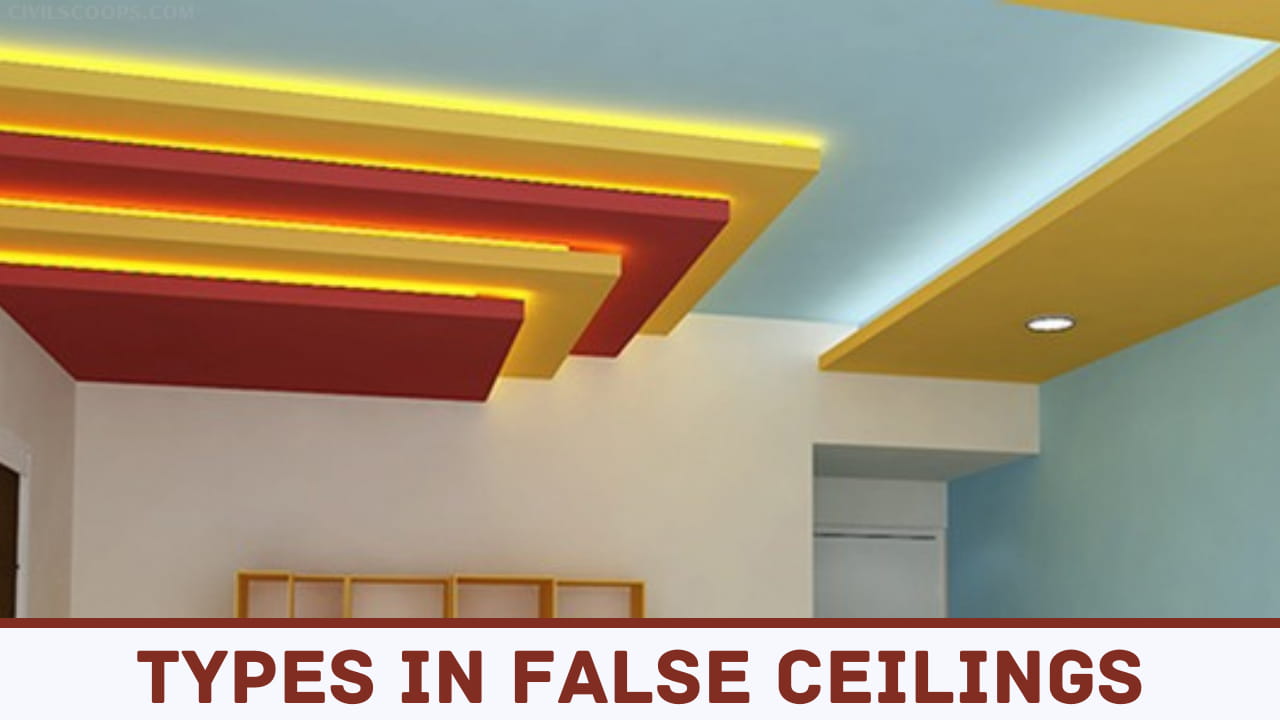
The choice of the type of false ceiling depends upon your requirement and design which suits your interior. The different types of false ceilings are as follows.
- POP False Ceiling
- Gypsum False Ceiling
- Wooden False Ceiling
- PVC False Ceiling
- Metal False Ceiling
1. POP (Plaster of Paris) False Ceiling
Plaster of Paris false ceiling is a commonly used type of false ceiling. These ceilings are made with the help of POP powder and manufactured as a dry powder and mixed with the water to form a
paste.
The main advantage of using plaster of Paris false ceiling is that it is highly durable and can sustain without any wear and tear. With the POP any type of ceiling design can be made.
There are chances of developing cracks in the plaster of Paris false ceiling. POP ceilings are the best for enhancing light conditions.
2. Gypsum False Ceiling
Gypsum ceilings are made up of hydrated Calcium sulphate and make the material very hard and flexible. Gypsum false ceilings are lightweight and easy to install. The various types of gypsum boards are available for the construction of a false ceiling.
The false ceiling of Gypsum board is available with the different sizes which are widely used in the commercial areas. The Gypsum false ceilings are widely used because of its sound insulation and the fire resistance properties. Gypsum is available in different colours such as white, brown, yellow, grey and red etc.
Gypsum is a flexible material so that it can be mould into the different shapes such as curved, circular and stepped.
3. Wooden False Ceiling
Wooden false ceilings are commonly used because of its natural texture and design. The wooden false ceiling gives the nature design look. The wooden false ceilings are best suitable when there are wooden beams that are used in the construction. Wooden false ceilings are the best ceiling which gives the natural look to the room.
4. PVC False Ceiling
PVC is polyvinyl chloride (PVC) is an ideal plastic material for the construction of a false ceiling. There are two types of PVC False Ceilings are available which are flexible false ceiling and solid false ceilings. The PVC panels are very quick and easy to install. The PVC False ceilings are very easy to install, light in weight and mostly used in the Bedrooms and kitchen rooms.
5. Metal False Ceiling
There are different types of metals are used in the false ceiling such as aluminium and galvanized iron. The Metal false ceiling is easy to install and durable. Metal false ceiling can be easily remote wale ever the maintenance is required.
Advantages of False Ceiling
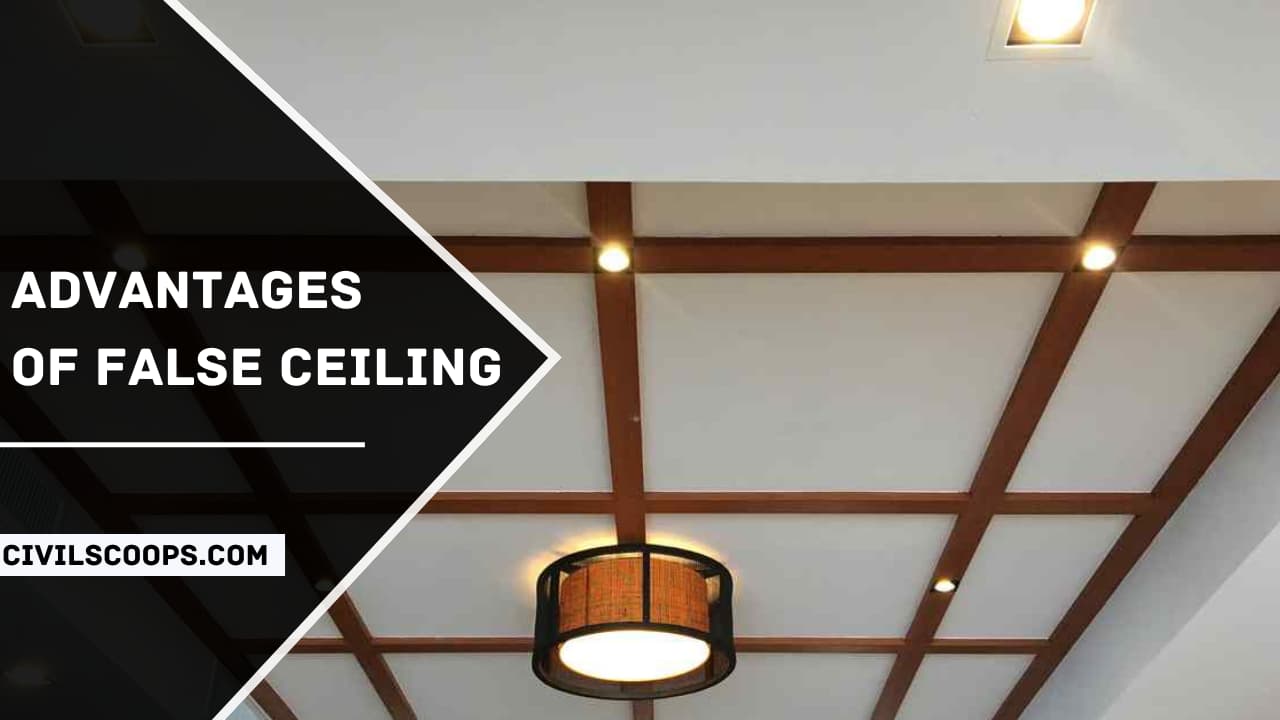
Here, the pros of false Ceiling are as follows.
- The various advantages of installing false ceiling are as follows
- False ceiling helps to increase the aesthetical beauty of the interior of the structure.
- The false ceiling help to hide the electric wiring, ductwork and pipes.
- False ceiling has a good acoustic and sound absorption
- The false ceiling provides the best Thermal Insulation which will help to maintain the temperature difference of exterior and interior
of the room. It will help to reduce the excessive heat in the room. - It helps to increase the lighting effect of the ceiling.
- The installation process of the false ceiling is very easy.
- The false ceiling will also help to improve the efficiency of the air conditioning in the room.
- The false ceiling will reflect more light and help to reduce the cost of lighting and electricity.
Disadvantages of False Ceiling
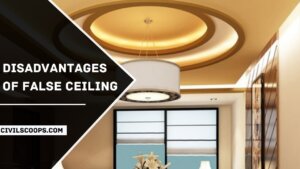
Here, the cons of false Ceiling are as follows.
- There may be chances of sagging in case of the false ceiling is not properly installed.
- There may be a risk of falling false ceiling in case of the natural calamities such as Earthquake.
- The false ceiling may absorb moisture if the nearby roof or wall is damp.
- The false ceiling reduces the height of the room.
- The false may sometimes undergo the termite attack.
- False Ceiling Installation Steps by Step
- Here is the step by step procedure for the installation of false ceiling
- First upon all the measurement of the ceiling are taken such as length and width and the height of the ceiling to wall.
- Before the installation of the false ceiling, all the electric wiring work is to be done.
- Then marking procedure is done as per the selected type of false ceiling. The different points are marked with respect to the
primary ceiling. - After that, the hooks and the frame structure of the metal or wood are fixed.
- The frame structure of steel or Aluminium is fixed on the primary sealing which acts as a base foundation for the installation of a
false ceiling. - The false ceiling sections are then installed on the
- If the false ceiling is made up of plaster of Paris when different shapes are moulded as per the requirement.
- The different sections of the boards which are used for the false ceilings are properly connected with each other.
- After the installation of the false ceiling, the lighting work is done on the false ceiling.
- Now the ceiling is ready for the painting and the final finish is given.
Important Point for Construction of False Ceiling
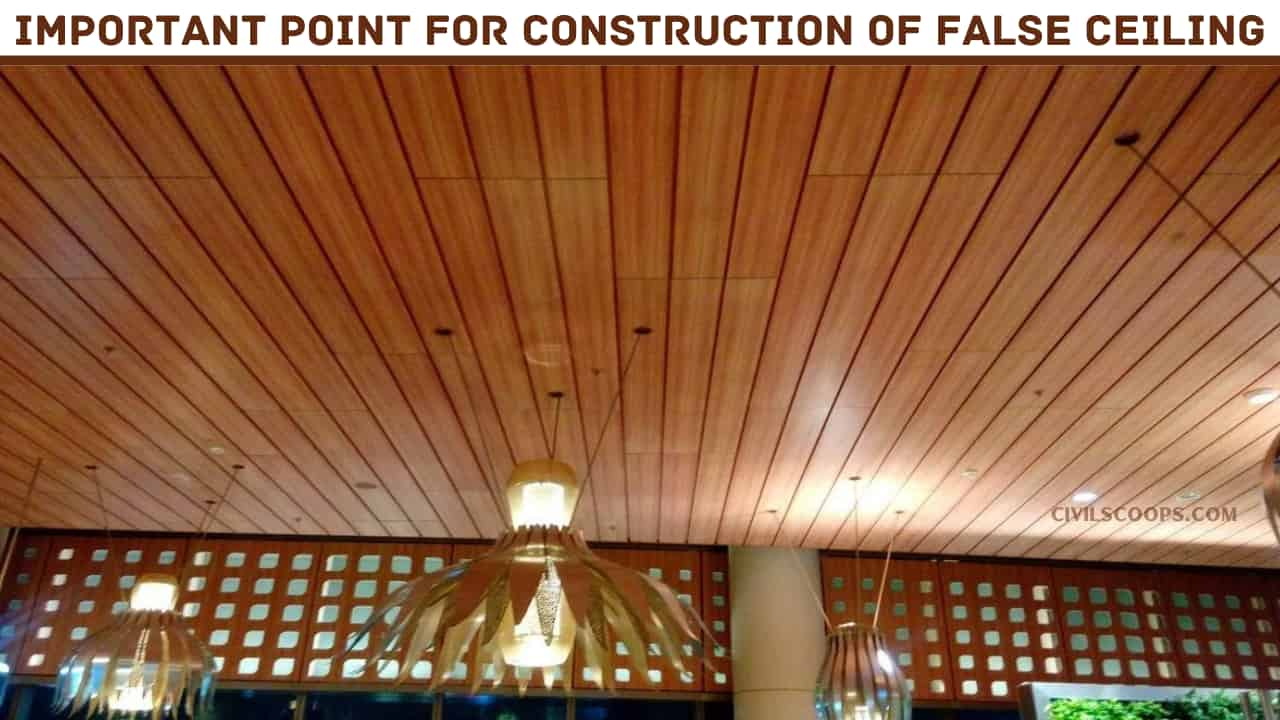
It is very necessary that some point should be considered while doing a false ceiling for your room. There are various types and design are available in the false ceiling.
The selection of the false ceiling depends upon the interior decor of your room.
- Type of Area
- Height of the Slab
- Maintenance and the Repair of the Ceiling
- Budget
1. Type of Area
The selection of the false ceiling depends upon the type of area where the ceiling is to be installed. The commercial areas required different types of false ceiling and our home interior required a different false ceiling.
2. Height of the Slab
Before the installation of the false ceiling, it is very important to know the height of the roof from the top to the bottom. The minimum height required for false ceiling installation should be 9 feet.
3. Maintenance and the Repair of the Ceiling
It is necessary that you should choose the false ceiling which required minimum maintenance and repair.
4. Budget
Budget is very important during the installation of the false ceiling in your house. If your budget is low then use the simple plain gypsum boards for the false ceiling work which is economical.
Cost of False Ceiling
Prices of false ceiling work are as follows
[su_table responsive=”yes” alternate=”no”]
| Type of False ceiling | Cost of False Ceiling |
| Plaster of Paris False Ceiling | Rs 150-200/square feet |
| Plain Gypsum Board False Ceiling | Rs 80-100/ square feet |
| PVC False Ceiling | Rs 120-150/ square feet |
| Mineral Fibre False Work | Rs 70- 150/ square feet |
| Wooden False Ceiling | Rs 110-200/ square feet |
[/su_table]
[su_box title=”FAQ” style=”default” box_color=”#333333″ title_color=”#FFFFFF” radius=”3″ class=”” id=””]
Types in False Ceilings
Here are the 8 major types of false ceilings widely used.
- Plaster of Paris (POP) False Ceilings.
- Wooden False Ceilings or Plywood False Ceilings.
- Gypsum False Ceilings.
- Metal False Ceilings.
- PVC False Ceilings.
- Fabric or Cloth False Ceilings.
- Mineral Fibre False Ceilings.
- Glass False Ceilings.
Advantages of False Ceiling
Here, the pros of false Ceiling are as follows.
- Aesthetically pleasing.
- Hides away electric conduits.
- Keeps the room cool.
- Soundproof ceiling.
- Reduces ceiling height.
- Cuts down on energy bills.
Disadvantages of False Ceiling
Here, the cons of false ceiling are as follows.
- Limits space in the room.
- Needs maintenance.
- Not as durable as traditional ceilings.
- Risk of fixtures falling off.
Gypsum False Ceiling Cost For 1BHK, 2BHK & 3BHK
Here, the below list of False Ceiling cost.
| Gypsum False Ceiling | 1 BHK (400 to 500 sq.ft) | 2 BHK (550 to 700 sq.ft) |
|---|---|---|
| Plain | Rs.40,000 | Rs.52,500 |
| 18″ Running Patta – Side corner only | Rs.60,000 | Rs.78,750 |
| Two Layer Ceiling | Rs.80,000 | Rs.1,05,000 |
[/su_table]
Gypsum False Ceiling Cost
[su_table responsive=”yes”]
| Thickness (in mm) | Minimum Price (Rs. per sq. ft.) | Maximum Price (Rs. per sq. ft.) |
| 1 | 40 | 450 |
| 10 | 20 | 240 |
| 12 | 40 | 150 |
| 16 | 50 | 110 |
[/su_table]
Pop False Ceiling Cost
[su_table responsive=”yes”]
| City | Gypsum*/ POP Rate Per Square Feet (in Rs.) | Wooden Rate Per Square Feet (in Rs.) |
| Mumbai | 75-120 | 100-800 |
| Pune | 125-170 | 85 (faux wood)-550 |
| NCR | 85-130 | 120-1,120 |
| Ahmedabad | 50-120 | 100-500 |
[/su_table]
Pvc False Ceiling Cost Per Square Feet
[su_table responsive=”yes”]
| Surface Treatment | Min Price | Max Price |
| Coated | Rs 45/Square Feet | Rs 95/Square Feet |
| Color Coated | Rs 38/Square Feet | Rs 120/Square Feet |
| Film Coated | Rs 32/Square Feet | Rs 125/Square Feet |
| Galvanised | Rs 60/Square Feet | Rs 100/Square Feet |
[/su_table]
False Ceiling Cost for Living Room
Plain and simple straight-line gypsum false ceilings from reputed brands start at ₹75 per square foot. However, the the cost of the false ceiling can become expensive and go up to ₹125 per square foot if the false ceiling needs to be elaborately designed.
Basement False Ceiling
Suspended ceilings are one of the most popular basement ceilings. Consisting of a simple grid and lightweight tiles or panels, a suspended ceiling covers exposed beams, ductwork, and electrical wiring, while allowing easy access for repairs or leaks.
What Is False Ceiling Made Of?
Gypsum boards and Plaster of Paris (POP) are two of the most commonly used materials for creating a false ceiling. While both have gypsum as a base, the two are different from each other.
Purpose of False Ceiling
False ceilings are essentially used for concealing wires, sound proofing, fire safety, energy efficiency and to help in moisture and sag resistance. Earlier, false ceilings were usually made of gypsum boards, but these days, it is easy to have false ceilings that are not only functional, but also decorative.
Does False Ceiling Reduce Heat
A kitchen false ceiling will also help with thermal insulation which will reduce the heating up of the kitchen. Since a kitchen false ceiling design also tends to be fire resistant, it also adds a layer of safety to your kitchen.
[/su_box]
[su_note note_color=”#F2F2F2 ” text_color=”#333333″ radius=”3″ class=”” id=””]
Like this post? Share it with your friends!
Suggested Read –
- Core Cutter Method | What is Compaction of Soil
- Difference Between Cement Plaster and Gypsum Plaster
- What Is Plaster | Plaster Ratio | History of Plastering | Requirements of Good Plaster
- What Is Self Compact Concrete | What Is Slump Flow Test | Equipment for Slump Flow Test | Procedure of Slump Flow Test
- What Is Gable Roof | History of Gable Roofing | Gable Roof Design | Parts of Gable Roof | 7 Types of Gable Roofs | How Long Can the Roof Last? | Gable Roof Advantages and Disadvantages | Cost of Gable Roof Construction |
[/su_note]
Originally posted 2022-07-13 12:08:19.
